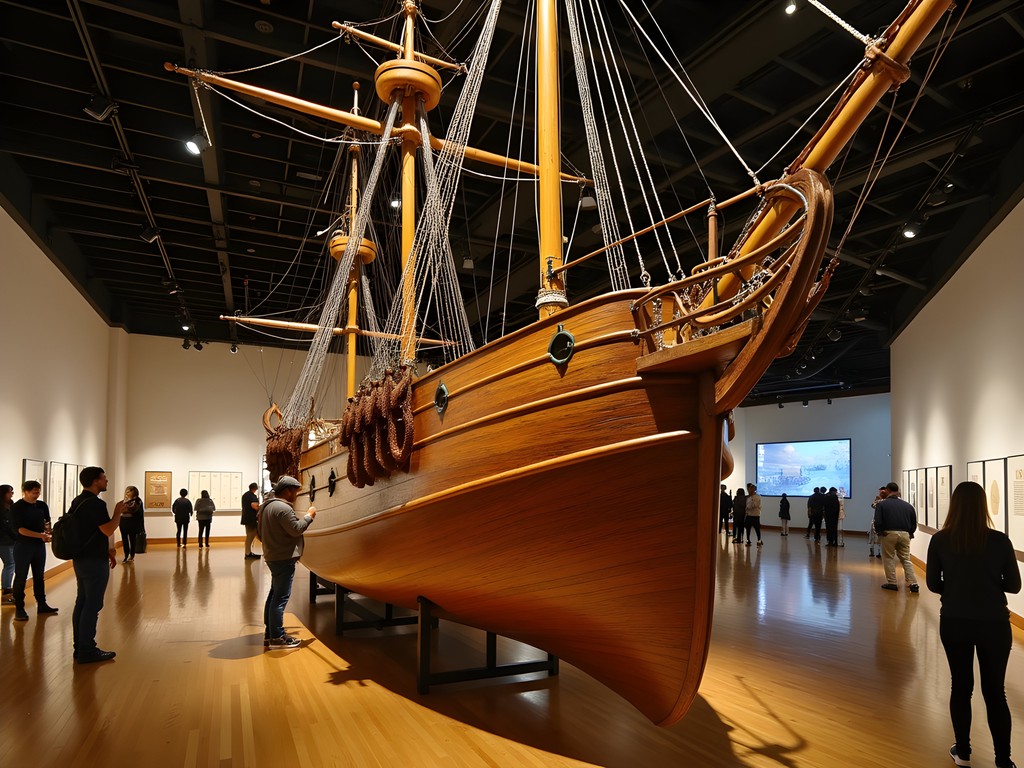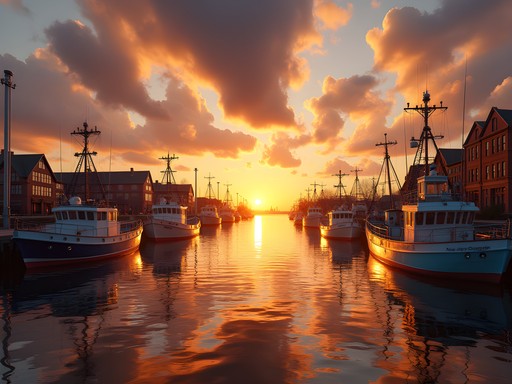Disclosure: This article contains affiliate links. We may earn a commission from purchases at no extra cost to you, which helps our travel content.
Standing at the bow of a life-sized ship replica inside the New Bedford Whaling Museum, I found myself transported to the 19th century—when this Massachusetts coastal city was the wealthiest per capita in America. The golden age of whaling may have faded, but New Bedford's cultural tapestry remains vibrantly intact, woven with Portuguese influences, maritime heritage, and a surprisingly progressive history. As an instructional designer constantly seeking design inspiration across cultures, this working-class city with its cobblestone streets and salt-tinged air offered far more than I expected during a recent weekend escape from my design conference in Boston.
The New Bedford Whaling Museum: A Design Masterpiece
As someone who studies how design shapes learning experiences, I was immediately struck by the thoughtful curation at the New Bedford Whaling Museum. This isn't your typical dusty collection of artifacts—it's a masterclass in experiential storytelling.
The crown jewel is undoubtedly the world's largest ship model, the Lagoda, a half-scale whaling ship you can actually board. Standing at the helm, I watched families engage with maritime history in ways textbooks could never capture. The museum's 4,000+ scrimshaw pieces (carved whale ivory) showcase extraordinary craftsmanship that had my designer brain buzzing with inspiration.
What truly sets this museum apart is how it balances celebrating the industry that built New Bedford while acknowledging its environmental impact. The exhibit on modern whale conservation efforts creates a thought-provoking juxtaposition with the historical displays. I spent nearly four hours exploring and could have easily stayed longer—bring your pocket sketchbook to capture design elements that catch your eye.

💡 Pro Tips
- Purchase the AHA! (Art, History, Architecture) Pass for $18 to access multiple historic sites
- Visit on the second Thursday evening of the month for free admission
- Don't miss the hourly presentations by former whalers' descendants who share personal family stories
Seamen's Bethel & Historic District: Walking Through Melville's Inspiration
Literature buffs will recognize New Bedford as the setting for the opening chapters of Herman Melville's Moby-Dick, and the Seamen's Bethel is where his character Ishmael attends a service before setting sail. The 1832 chapel still stands, complete with the distinctive prow-shaped pulpit Melville described. Sitting in the worn wooden pews where generations of whalers prayed before dangerous voyages, I felt a profound connection to the past.
The surrounding Whaling National Historical Park encompasses 13 city blocks of cobblestone streets lined with grand Federal-style mansions built by wealthy whaling merchants. My husband Carlos and I spent a blissful afternoon wandering with our audio guide loaded with the free National Park Service tour. We discovered hidden courtyards, sailor boardinghouses, and the New Bedford Whaling National Historical Park Visitor Center, where rangers offer free guided tours.
Don't miss the Rotch-Jones-Duff House and Garden Museum, an 1834 Greek Revival mansion that offers a glimpse into the domestic life of a whaling merchant. The formal gardens are particularly lovely in spring and summer.

💡 Pro Tips
- Download the free NPS app for self-guided walking tours of the historic district
- The Seamen's Bethel is still an active place of worship—check service times to plan around them
- Many historic buildings are not wheelchair accessible—call ahead for accommodation information
The Unexpected Art Scene: From Whaling to Wall Murals
What surprised me most about New Bedford was its vibrant contemporary art scene. The city has reinvented itself as a creative hub, with over 70 working artists maintaining studios in former textile mills and fishing warehouses. The transformation of industrial spaces into creative venues reminded me of similar design evolution I've documented in Colombia's coastal cities.
The cornerstone of this renaissance is the Massachusetts Design Art and Technology Institute (DATMA), which hosts free public art installations throughout downtown. During my visit, an exhibition exploring the intersection of traditional Portuguese textiles and modern design perfectly aligned with my professional interests.
The New Bedford Art Museum/ArtWorks! occupies a former bank building and showcases both contemporary work and historical pieces. I was particularly moved by an exhibition featuring artifacts from the Underground Railroad—New Bedford was a major destination for escaped slaves due to its abolitionist community and opportunities for work in the whaling industry.
For photography enthusiasts, the city's collection of vibrant murals makes for perfect photo opportunities. I captured dozens of compelling images with my travel camera, particularly in the transforming Seaport Cultural District.

💡 Pro Tips
- Visit during AHA! Night (second Thursday monthly) when galleries stay open late with free programming
- Check DATMA's website for their rotating outdoor installations schedule
- The Co-Creative Center on Union Street offers workshops where you can learn traditional crafts from local artisans
Portuguese Influence: A Culinary and Cultural Journey
New Bedford boasts the highest percentage of Portuguese-Americans in the United States, a legacy of Azorean and Cape Verdean sailors who joined whaling crews in the 19th century and eventually settled here. This heritage is deliciously evident in the city's food scene.
Carlos and I started our culinary exploration at Antonio's Restaurant, where we feasted on traditional Portuguese kale soup (caldo verde) and bacalhau à gomes de sá (salt cod casserole). The restaurant has been family-owned for generations, and the recipes taste like they've been perfected over centuries.
For a more casual experience, the Whaling City Diner serves Portuguese-American fusion breakfast all day. Their malasadas (Portuguese donuts) paired with locally roasted coffee made for the perfect morning fuel before exploring. I always travel with my food journal to document culinary discoveries, and these flavor combinations definitely earned several pages of notes.
The highlight of our gastronomic adventure was the Feast of the Blessed Sacrament, North America's largest Portuguese festival held annually in early August. Though we visited in October, many restaurants still displayed photos from the celebration, and locals eagerly shared stories of the four-day feast featuring traditional music, dancing, and endless food stalls serving specialties from different Portuguese regions.

💡 Pro Tips
- Reserve a table at Antonio's at least a week in advance—locals pack this place nightly
- If visiting in August, book accommodations months ahead due to the Feast of the Blessed Sacrament
- Ask for linguiça (Portuguese sausage) as an add-on to almost any breakfast dish—it's a local specialty
Harbor Tour: Connecting Past and Present
To truly understand New Bedford, you need to see it from the water. The working harbor remains one of America's most profitable fishing ports, with over 500 vessels bringing in primarily scallops and groundfish. We boarded the Harbor Tour vessel with Captain Jack, a retired fisherman whose family has worked these waters for five generations.
The 90-minute tour took us past massive scallop boats, the hurricane barrier (largest on the East Coast), and historic Palmer's Island Lighthouse. Captain Jack's narration blended historical facts with personal anecdotes about the changing fishing industry. I was fascinated by the contrast between 19th-century whaling practices and today's sustainable fishing efforts.
For the best views, I recommend bringing a compact binoculars to spot harbor seals that frequently appear near the jetties. The tour provides excellent photography opportunities, especially in the golden hour before sunset when the light bathes the harbor in warm hues.
What struck me most was how the harbor represents both continuity and transformation—fishing vessels now return with scallops instead of whale oil, but the fundamental relationship between New Bedford and the sea remains unchanged. As a designer always looking for visual metaphors, this juxtaposition of past and present was profoundly inspiring.

💡 Pro Tips
- Book the sunset tour for the best lighting and smaller crowds
- Bring layers—the harbor is significantly cooler than downtown, even in summer
- Ask Captain Jack about his family's fishing logbooks—he sometimes brings historical documents to share
Final Thoughts
As our weekend in New Bedford drew to a close, I found myself reluctant to leave this authentic slice of American maritime heritage. Unlike more polished tourist destinations, New Bedford offers something increasingly rare—an honest working city that wears its history openly while steadily evolving. The design elements I encountered throughout the city—from scrimshaw carvings to contemporary murals—will influence my instructional design work for months to come.
New Bedford reminded me why cultural immersion matters: it reveals the connections between past and present, between different cultural traditions, and between human innovation and natural resources. For couples seeking a weekend escape that balances historical depth with contemporary creativity, New Bedford delivers an experience far richer than many better-known destinations.
As I watched one final sunset paint the harbor in gold and rose hues, I made a mental note to return during the Portuguese festival season. There are still stories waiting to be discovered in the Whaling City, and I've only just begun to understand its depths.
✨ Key Takeaways
- New Bedford offers an authentic cultural experience beyond typical tourist destinations
- The city perfectly balances historical preservation with contemporary art and culinary scenes
- Portuguese cultural influences create a unique cultural and culinary landscape not found elsewhere in New England
📋 Practical Information
Best Time to Visit
May-October, with August featuring the Portuguese Feast
Budget Estimate
$400-600 for a weekend (accommodations, meals, and activities)
Recommended Duration
2-3 days
Difficulty Level
Easy
















Comments
seafarerJim
Just got back from New Bedford and followed many of your recommendations, Maya. The Seamen's Bethel was exactly as you described - stepping into the pages of Moby Dick! What really surprised me though was the quality of Portuguese food. We tried Adriana's (thanks for that tip!) but also discovered a tiny place called Viva Portugal that served the most incredible bacalhau I've had outside of Lisbon. The owner told us his family has been in New Bedford for four generations but still uses recipes from the old country. Also worth noting that the New Bedford Whaling National Historical Park offers free ranger-led tours that add so much context to the self-guided walking tour.
happylife
Adding Viva Portugal to my list! Is it walking distance from the Whaling Museum?
seafarerJim
Yes! Maybe 10 minutes max. It's tiny though, so go early or be prepared to wait.
travelwithlisa
If anyone's planning a visit, try to catch the AHA! Night (Art, History & Architecture). It's on the second Thursday each month and all the museums stay open late with free admission. We stumbled on it by accident and it was the highlight of our trip!
happylife
This looks amazing! Did you find it easy to get around New Bedford without a car? Planning a weekend trip but wondering about transportation options.
Maya Reyes
The historic district is very walkable! We took the bus from Boston (about 1hr 15min) and then used rideshares a couple times to reach spots outside downtown. The SRTA buses run through the main areas too.
roamhero
We rented bikes from Whaling City Bike Shop and it was perfect for exploring. Most sites are within a 10-15 min ride of each other.
Frank Garcia
Maya, your piece on New Bedford really resonates with my experience there last year. The juxtaposition of the city's industrial past with its emerging arts scene creates a fascinating cultural landscape that few American port cities maintain so authentically. I particularly appreciated your analysis of the Portuguese influence - I spent an entire afternoon exploring the neighborhoods you mentioned and discovered António's Bakery which serves malasadas that transported me straight back to the Azores. The historical connection between New Bedford and Portugal's maritime communities is a thread worth pulling for anyone interested in immigration patterns along the Eastern Seaboard. Did you have time to visit the Fishing Heritage Center as well? It provides an interesting complement to the Whaling Museum's narrative.
Maya Reyes
Thanks for the thoughtful comment, Frank! I didn't make it to António's or the Fishing Heritage Center - definitely adding both to my list for next time. The Portuguese connection really does add such richness to the city's story.
Frank Garcia
You'll love António's! I used my travel journal to sketch the harbor while enjoying their pastries. Perfect morning.
roamhero
Just visited the Whaling Museum last month! The ship replica is even more impressive in person than your photos show.
Maya Reyes
Thanks roamhero! You're right - photos really don't do it justice. The scale is incredible!
happylife
Did you catch one of the scrimshaw demonstrations? We missed it and I'm still kicking myself!
roamhero
I did! They only do them on weekends though. Definitely worth planning around if you go back.
familyvacationer
Would you recommend New Bedford for a family with kids (ages 8 and 11)? They love museums but get bored easily!
Nicole Russell
Not Maya, but I think your kids would love it! The Whaling Museum has lots of interactive exhibits - my nephew was fascinated by the massive whale skeletons hanging from the ceiling. They also have special programs for kids where they can learn knot-tying and other sailor skills.
familyvacationer
That sounds perfect! Thanks for the insight, Nicole!
nomadninja
Great post! The Whaling Museum was definitely a highlight of our New England trip last year. The scrimshaw collection is incredible - I had no idea how detailed and artistic these pieces could be. We also found this amazing little Portuguese restaurant called Antonio's that served the best linguiça I've ever had. Has anyone tried the walking tour that connects to Moby Dick locations? We ran out of time for that.
Casey Andersson
Maya, your post brought back wonderful memories! I visited New Bedford last year and was equally captivated by its maritime charm. The Whaling Museum is truly world-class - I spent nearly 4 hours there and still didn't see everything. One tip for anyone planning a visit: the historic district is incredibly photogenic at sunrise when the cobblestone streets are bathed in golden light. I stayed at the Fairfield Inn right downtown which made early morning photography walks so convenient. Also, don't miss the free walking tour that starts at the visitor center on Saturday mornings - our guide was a former fisherman with fascinating stories about the harbor's evolution from whaling to modern fishing. I'm curious - did you make it to the Rotch-Jones-Duff House? That mansion gave me such insight into how the whaling fortunes shaped the city's architecture.
Maya Reyes
Casey, thanks for the thoughtful comment! I did visit the Rotch-Jones-Duff House - absolutely stunning example of Greek Revival architecture. The gardens were particularly lovely. Great tip about the sunrise photography - wish I'd thought of that!
starperson
That walking tour sounds perfect! Is it available year-round or just summer?
Casey Andersson
@starperson I believe they run from April through October, but best to check the visitor center website to confirm. Definitely worth planning around!
starperson
How much time would you recommend spending at the Whaling Museum? Is it kid-friendly?
Maya Reyes
I'd say 2-3 hours minimum! It's surprisingly large and very kid-friendly with interactive exhibits. The half-scale whaleboat and ship models were huge hits with families when I visited. They also have special programs for kids during school breaks.
cooladventurer
Great post! Did you try any specific Portuguese restaurants you'd recommend? Planning a weekend trip there in October.
Maya Reyes
Absolutely! Antonio's Restaurant had amazing authentic Portuguese cuisine - their bacalhau was incredible. Also try Tia Maria's European Cafe for breakfast. The pastéis de nata are worth the trip alone!
cooladventurer
Thanks so much! Adding those to my list. Can't wait to try the pastéis de nata!
Venture X
Premium card with 2X miles, $300 travel credit, Priority Pass